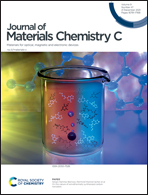Layer number-dependent optoelectronic characteristics of quasi-2D PBA2(MAPbBr3)n−1PbBr4 perovskite films†
Abstract
Halide perovskites have attracted attention because of their potential in the fields of light-emitting diodes, lasers and detectors. Herein, a series of quasi-2D PBA2(MAPbBr3)n−1PbBr4 perovskite films have been synthesized and the physical behavior behind their optoelectronic properties, which is dependent on the layer number (n), has been discussed in detail. The temperature-dependent photoluminescence (PL) test indicates that the perovskite film with n = 7 has outstanding PL characteristics, owing to its long radiative lifetime at different temperatures. Temperature-dependent amplified spontaneous emission (ASE) has been employed for the first time to scan the ASE threshold of our films, showing that the ASE threshold decreases from 29.91 μJ cm−2 (3D perovskite film) to 19.23 μJ cm−2 (n = 3). The current–voltage test with strong light bias takes the lead in pointing out that the detector based on the 3D perovskite film (n = ∝) exhibits excellent opto-current properties in comparison with other quasi-2D perovskite films. Our results provide a comprehensive insight into the optoelectronic properties of these quasi-2D perovskite films.



 Please wait while we load your content...
Please wait while we load your content...